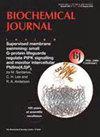DoUBLing起来:泛素和泛素样蛋白酶在基因组稳定性中的作用
IF 4.4
3区 生物学
Q2 BIOCHEMISTRY & MOLECULAR BIOLOGY
引用次数: 0
摘要
保持基因组的稳定性需要专门的 DNA 修复和信号传递过程,这对染色体的忠实复制和繁殖至关重要。这些 DNA 损伤应答(DDR)机制可抵消日常外源性和内源性基因毒性压力可能造成的诱变影响。这些 DNA 修复途径的内在要素是蛋白质因子的活性,它们在 DNA 损伤发生时启动修复过程。这些 DDR 因子的调控、协调和安排在很大程度上是通过翻译后修饰进行的,如磷酸化、泛素化和泛素样蛋白(UBLs)修饰。泛素化和与 SUMO 的 UBL 化在 DNA 修复中的重要性已得到公认,被修饰的目标和下游信号后果也相对明确。然而,泛素和 UBLs 的专用清除剂(分别称为去泛素化酶(DUBs)和泛素样蛋白酶(ULPs))在基因组稳定性中的作用还不太明确,尤其是对于 ISG15 和 UFM1 等新出现的 UBLs。在这篇综述中,我们概述了参与基因组稳定性途径的 DUBs 和 ULPs 的已知调控作用和机制。扩大我们对消除泛素和 UBL 修饰的分子介质和机制的认识,将是促进我们对 DDR 的了解的基础,并有可能为癌症等相关人类疾病提供新的治疗途径。本文章由计算机程序翻译,如有差异,请以英文原文为准。
DoUBLing up: ubiquitin and ubiquitin-like proteases in genome stability
Maintaining stability of the genome requires dedicated DNA repair and signalling processes that are essential for the faithful duplication and propagation of chromosomes. These DNA damage response (DDR) mechanisms counteract the potentially mutagenic impact of daily genotoxic stresses from both exogenous and endogenous sources. Inherent to these DNA repair pathways is the activity of protein factors that instigate repair processes in response to DNA lesions. The regulation, coordination, and orchestration of these DDR factors is carried out, in a large part, by post-translational modifications, such as phosphorylation, ubiquitylation, and modification with ubiquitin-like proteins (UBLs). The importance of ubiquitylation and UBLylation with SUMO in DNA repair is well established, with the modified targets and downstream signalling consequences relatively well characterised. However, the role of dedicated erasers for ubiquitin and UBLs, known as deubiquitylases (DUBs) and ubiquitin-like proteases (ULPs) respectively, in genome stability is less well established, particularly for emerging UBLs such as ISG15 and UFM1. In this review, we provide an overview of the known regulatory roles and mechanisms of DUBs and ULPs involved in genome stability pathways. Expanding our understanding of the molecular agents and mechanisms underlying the removal of ubiquitin and UBL modifications will be fundamental for progressing our knowledge of the DDR and likely provide new therapeutic avenues for relevant human diseases, such as cancer.
求助全文
通过发布文献求助,成功后即可免费获取论文全文。
去求助
来源期刊

Biochemical Journal
生物-生化与分子生物学
CiteScore
8.00
自引率
0.00%
发文量
255
审稿时长
1 months
期刊介绍:
Exploring the molecular mechanisms that underpin key biological processes, the Biochemical Journal is a leading bioscience journal publishing high-impact scientific research papers and reviews on the latest advances and new mechanistic concepts in the fields of biochemistry, cellular biosciences and molecular biology.
The Journal and its Editorial Board are committed to publishing work that provides a significant advance to current understanding or mechanistic insights; studies that go beyond observational work using in vitro and/or in vivo approaches are welcomed.
Painless publishing:
All papers undergo a rigorous peer review process; however, the Editorial Board is committed to ensuring that, if revisions are recommended, extra experiments not necessary to the paper will not be asked for.
Areas covered in the journal include:
Cell biology
Chemical biology
Energy processes
Gene expression and regulation
Mechanisms of disease
Metabolism
Molecular structure and function
Plant biology
Signalling
 求助内容:
求助内容: 应助结果提醒方式:
应助结果提醒方式:


